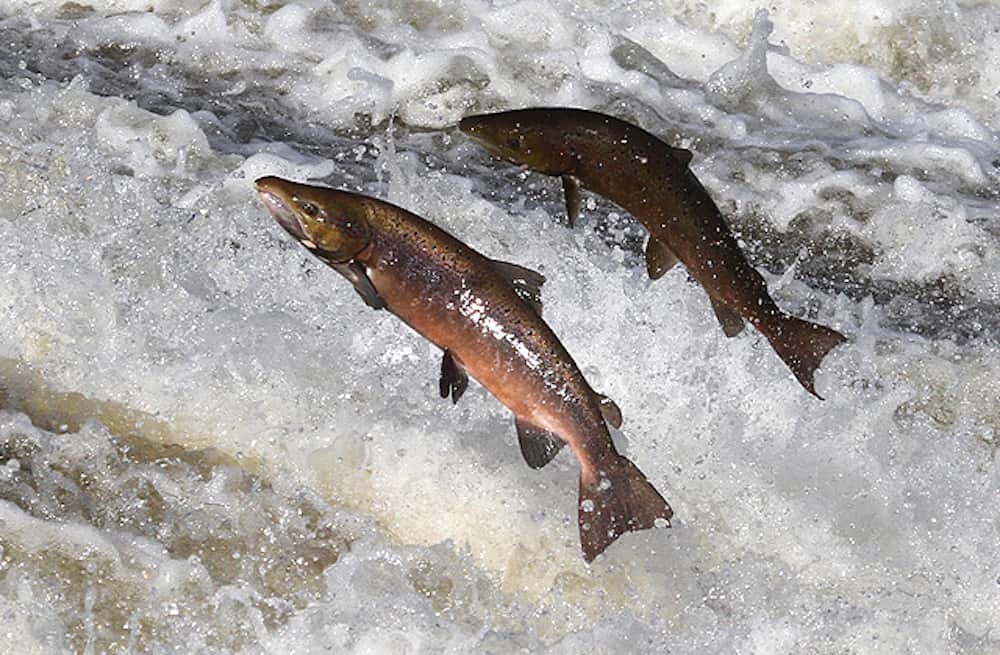
[Image above] An autumn run of salmon are trying to progress upstream to breeding grounds on the Ettrick Water near Selkirk, Scotland. Credit: Walter Baxter (CC BY-SA 2.0)
When considering the environmental impacts of various types of food production, much focus is given to the beginning of the production process, or how the animals or plants are raised. However, there are also critical impacts to consider when disposing of organic waste.
“Once [discarded] food gets to the landfill, it then generates methane, a greenhouse gas 23 times as potent as carbon dioxide in trapping heat within our atmosphere. According to the U.S. Environmental Protection Agency, landfills account for 34 percent of all methane emissions in the U.S.,” a Scientific American article explains.
To avoid food waste, many companies in the meat industry render their byproducts, a process of converting discarded animal tissue into usable materials. For example, hog byproducts are used to produce medicines like insulin, the blood thinner heparin, and the antibiotics amoxicillin, ampicillin, and penicillin.
Compared to other meats, fish remains a relatively underutilized waste source in rendering processes, despite it being a great source of minerals, proteins, and fat. Studies estimate that about two-thirds of the total amount of fish caught is discarded as waste, so finding ways to render the waste is essential to improving sustainability of the fishing industry.
In an open-access paper published last October, researchers from Turkey, Uzbekistan, Romania, and Japan investigated the possibility of deriving calcium phosphate, particularly hydroxyapatite, from salmon fish bone wastes.
Hydroxyapatite is a naturally occurring mineral form of calcium apatite with the formula Ca5(PO4)3OH. It comprises about 70% of bones by weight, and calcium phosphate bioceramics with hydroxyapatite as the main phase are commonly used as a filler to substitute damaged bone or as a coating on implants to support bone growth.
Hydroxyapatite can be synthetically produced from chemicals, but researchers have discovered that when it is derived from natural sources, the contribution of trace elements such as magnesium, zinc, and strontium provide advantages to the material’s mechanical and biocompatible properties.
Previous studies have investigated converting fish bone wastes into hydroxyapatite. However, for this material to be useful in biomedical applications, the mechanical and biocompatible properties must be investigated in bulk form. And that bulk investigation is what the international team of researchers looked to do in their study.
They boiled salmon fish bones in water to remove skin and flesh, and then cleaned the bones via treatment with 1% sodium hydroxide solution to remove proteins, lipids, and other organic impurities. They calcined the bones in an 800°C oven before grinding the bones into a powder, which was pressed into pellets and sintered.
X-ray diffraction analysis of the calcium phosphate pellets showed they mainly consisted of hydroxyapatite and tricalcium phosphate crystal phases, a composition close to that of some commercially available biphasic calcium phosphates.
Subsequent in vitro biocompatibility tests showed promising results as well—human osteosarcoma (Saos-2) cells attached and proliferated on the calcium phosphate pellets, indicating the bioceramics had no cytotoxicity effect.

“These findings indicate that natural CaP [calcium phosphate] produced from salmon bones constitutes a cost-effective and environmentally friendly CaP source, maintaining the normal oligoelements of the natural bones, such as Mg2+,” the researchers write.
However, they add that “further works will be necessary to analyze the presence of the trace elements (heavy metals as well as the level of the desired oligoelements) in the fish-derived CaP.”
The open-access paper, published in International Journal of Molecular Sciences, is “Mechanical and biocompatibility properties of calcium phosphate bioceramics derived from salmon fish bone wastes” (DOI: 10.3390/ijms21218082).
